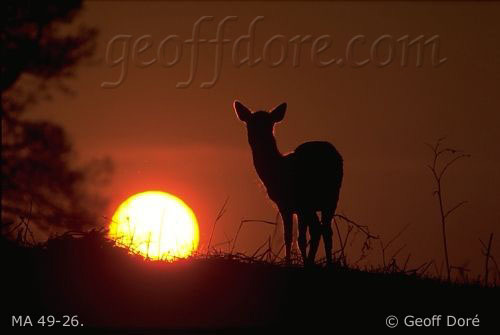

Fallow Deer doe with setting sun, England
 |
Photographed using a Nikon FE2 camera with motordrive and Nikkor 300mm
lens with a Vivitar 2x teleconverter mounted on a Benbo tripod; taken at about 1/125th second at f8
on Kodachrome 64 film rated at ISO 64 and processed normally; no filters used.
New Forest, Hampshire, England, March. |
| The story behind the picture .... |
| "I was walking through some lovely oakwoods in
the New Forest one spring evening as the sun began to slip toward the horizon.
Approaching the
edge of the woodland I noticed this lone Fallow Deer doe some distance away,
grazing about 50 metres out from the trees. Quickly, I assessed the wind
direction and realised that I could circle round using the woods for cover
and then approach the deer from the woodland edge, remaining downwind all
the time, with the object of shooting the deer on the skyline as the sun
dropped down behind her.
"That was the theory - putting it into practice was a little trickier! "With my camera set up with an effective 600mm lens (300mm with 2x teleconverter) I deftly stepped back into the woodland - and the cracks of several twigs echoed through the quiet evening! With a bit more caution I made my way through the shadowy oakwood in the dimming sunlight, circling around and then beginning my final approach. Twigs seemed to jump under my footfalls, cracking almost like gunfire and forcing me to freeze statue-like several times, but as I came closer to the edge of the wood I could see my quarry still peacefully grazing in the open about 60 metres away and occasionally looking out for danger. She was nicely positioned on the skyline as I'd hoped and by this time the sun was rapidly approaching the horizon, losing its intensity and becoming much 'kinder' for photography (and for my eyes!). "One of the problems with photographing wild deer is that there is usually more than just one around and often I've carefully stalked a 'target' deer only to discover that another one that I hadn't spotted had been watching me all the time! The stalk then usually ends abruptly when the watching deer gives its short bark of alarm, alerting all deer nearby to my presence. The trick is to spot all the deer before they spot you! - on this occasion I looked around very carefully and the only other deer that I could see were much farther away and posed no problem. "Now for the final approach from the edge of the oakwoods - a quick check of the film counter(!), then a meter reading of the sky above the setting sun and adjustment of camera settings. Using a slight hollow in the open ground between myself and the Fallow doe, I began to creep slowly towards her, keeping low and just below the rise, timing my movements to when she had her head down or was facing away. "After about 20 metres, I cautiously raised myself to a half-crouch and saw the Fallow doe just 30 metres away, still grazing contentedly and oblivious of my presence. The setting sun was still a little too bright and wasn't yet in quite the right position and so I had to duck back down and wait for five nerve-wracking minutes. My next look showed everything was falling in place, with the doe at a good angle and the golden orb of the sun just hitting the horizon beside her, so I quietly raised the tripod, set the camera and framed the shot. "At the first shot, the grazing deer startled at the sound of the shutter/motordrive and raised her head, looking toward me intently. From past experience of trying to slowly manually wind-on film rather than use a noisy motordrive, I'd found that many mammals are more likely to spook from movement, however slight, rather than from the noise, and so I remained virtually motionless in a crouched position (in camouflaged clothing, etc) and fired off two more shots in quick succession. "Expecting the doe to bolt, I was surprised when she remained where she was and just glanced to one side a couple of times, before staring back towards me at another sound from the camera. However, I only bagged four more frames before she decided enough was enough and, with a short bark of alarm, she bounded off towards the safer embrace of the oakwood. "I knew that the setting sun had given some lovely rim-lighting to the doe's silhouette and that I had some good images in the can but it wasn't until I got the processed film back later that I saw how the individual hairs of the doe's body were individually rim-lit also, adding to the overall effect. "Even though the picture was taken a number of years ago, it still remains one of my personal favourites and one of my most personally evocative images, reminding me of a particularly intimate and wonderful encounter with the epitome of wildness." 
Geoff Doré |
Back to Larger Image
Another story ... Stories... Index
Prints Image Files Categories Main Index Enquiry Form

This page last revised: Jan 2002

Our e-commerce web site with full search facilities is at
www.geoffdore.com